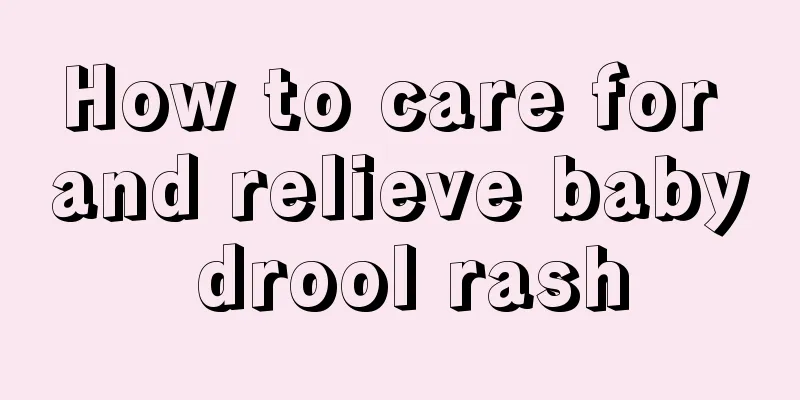How to care for and relieve baby drool rash

|
My baby is always drooling and has many small rashes on his chin. Is there any way to cure it? This is a problem many mothers encounter when caring for their babies. In fact, these small rashes are the so-called drool rashes. So how to care for and treat drool rash? Let’s see what parenting experts have to say. Drool rash is caused by the skin being frequently stimulated by physical factors such as moisture and friction, which can cause damage to the skin's stratum corneum and cause drool rash. Its clinical manifestations are local skin flushing, pain, and mild swelling, most often occurring around the lips. In fact, it is a process for babies to drool. Newborn babies do not drool because their salivary glands are underdeveloped and secrete less saliva, so there is no excess saliva flowing out of their mouths. In addition, the baby's staple food at this time is milk or liquid food, which does not stimulate the salivary glands much. The teething period is the time when babies drool most frequently. When the deciduous teeth erupt, the small teeth push outward from the gums, which can cause mild swelling and discomfort in the gum tissue, stimulate the nerves on the gums, and reflexively increase the secretion of the salivary glands. However, since saliva is acidic and contains digestive enzymes and other substances, they will not invade deeper layers because of the protection of the mucous membrane in the mouth. However, when saliva flows onto the skin, it can easily corrode the outermost stratum corneum of the skin, causing skin inflammation and triggering pediatric skin diseases such as eczema. How to Care for and Relieve Drool Rash? Pediatric expert Cui Yutao said that drool rash is related to contact with food or saliva stimulation. If you keep the area dry and use some moisturizer appropriately, the effect will definitely be good, but it is not easy to keep the skin around the mouth dry! Furthermore, applying lotion around the mouth can easily get into the mouth, and there are concerns about side effects. Therefore, it is recommended to wash it with clean water, dry the area with dry and soft gauze, and then apply a thin layer of olive oil. The effect will be good and safe. Mothers are reminded to wipe away their baby's saliva at any time during the baby's teething period. Do not wipe too hard, just wipe away the saliva gently to avoid damaging the local skin. The handkerchief used to wipe the baby's saliva should be soft and made of cotton, and should be washed and ironed frequently. Wash away saliva regularly with warm water, then apply a mild lubricant (such as coconut oil, almond oil, or safflower oil on a cold cotton ball) to protect the skin on your chin and neck. If your baby already has drool rash, you can try applying sesame oil or sesame oil to your baby and then apply an eczema ointment. |
<<: Symptoms of poor absorption in babies and ways to improve them
>>: What are the methods for boys to grow taller during puberty?
Recommend
Can children's loose teeth be extracted?
Everyone will experience a period of tooth replac...
How to remove lead from children with high lead levels
Many children often bite pencil tips, eat foods c...
Symptoms of childhood variant asthma
Many parents are very concerned about their child...
What can I do to make my child’s dark face white?
In the Chinese aesthetic concept, fair skin is mo...
What tests are needed for children with ADHD?
Attention Deficit Hyperactivity Disorder (ADHD) i...
Why does my 20-day-old baby not sleep?
Why doesn’t a 20-day-old baby sleep? A 20-day-old...
What to do if sand gets into a child's eyes
Children often encounter the situation of sand or...
What to do if your child has gallstones
Gallstones are a disease that is generally common...
What should I do if my child’s face is swollen after falling?
Children are naughty by nature, so it is easy for...
What should I do if my child catches a cold and urinates frequently?
Compared with adults, children have relatively po...
What's wrong with the baby's vomiting blood?
The birth of a baby makes the mother who has just...
What should I do if my child has a fever and stomachache?
Generally, children have poor resistance and may ...
What is the normal value of jaundice in children?
For children, there is generally one thing that n...
How to treat cerebral palsy in children
Every family wants to have a healthy, cute and sm...
How much milk does a three-month-old baby drink?
After the baby reaches three months old, he alrea...









